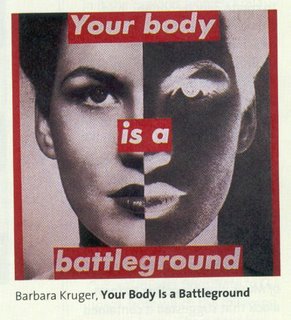 According to Chapter 3, 'The Body', of Dani Cavallaro's 'Critical and Cultural Thoery', within recent years the human body has become an ever-growing nucleus of media attention. We all have one, so why this increased fascination with the human body?
According to Chapter 3, 'The Body', of Dani Cavallaro's 'Critical and Cultural Thoery', within recent years the human body has become an ever-growing nucleus of media attention. We all have one, so why this increased fascination with the human body?Well according to some critics, this growing interest has been attributed to what Western thought traditionally marginalized as 'merely fashionable'; whilst other critics contend that the body has become so notorious 'as a result of intimations of its disappearance' (Cavallaro, p97).
Disappearance..?! Fret not, we human have a good couple of millions of years until we disappear from the face of the Earth and become an extinct species; but what is actually meant by 'disappearance' is more of a virtual meaning, as opposed to a literal meaning. In this context 'disappearance' here relates to the emergent culture of disembodiment brought on by the computer technology revolution and the subsequent replacement of physical contact for tele-presence. Thus, the prespective here stems from recognising the evolving significance of the body, in this quickly mutating scene of socio-economics and the technology boom.
W.A Ewing who said that the body which is being put squarely in the centre of debate out of urgency, is so because it is being 'restructred and reconstituted by scientists and engineers' (Cavallaro, p97). And indeed so, in recent years the body has been dramatically reassessed by both science and philosophy. On the one hand, science has shown the body can be 'disassembled and restructured', and philosophy still challenges 'the traditional superiority of the mind over the body'.
The Body: A Cultural Concept
Nonetheless, the body has been redefined from merely a physical form into a cultural concept: a means of encoding a society's values through its shape, size and ornamental attributes. According to Adler and Pointin, '[t]he body is..both an object represented..and an organism that is organised to represent concepts and desires'.
As can be contained, the body is a very difficult entity to define, due to its composite and multi- layered nature. Nevertheless, there have been many attempts to do this on both biological and figurative planes. From a scientific perspective, there's the Human Genome Project, for example, which attempts to map out all the body's genes; and from a figurative perspective, 'idiomatic expressions' such as 'filled with anger' or 'brimming with tears' further emphasise the instability of the body's boundaries and the obvious frustrated attempts at clearly defining the body.

But regardless of this instability, the body plays a vital role in the way we interpret the world around us, our assumptions of social identities, and our knowledge acquisition, for as Maurice Merleau-Ponty points out '..the world derives its meanings not from fixed and intrinsic attributes but from how it is perceived and acted upon by an embodied consciousness' (Cavallaro, p99). Roger Poole also adds to that '..the body actually lives a world, and thus projects 'its' values over a world' (Cavallaro, p99).
Acquisition of Knowledge: Body Schema and Body Image
In the role played by the body in the acquisition of knowledge, two distinctions must be made: body schema, and body image.
Body Schema refers to an instinctive and unconscious attunement to an individual's environment; for example, shifting one's posture to keep one's balance on a moving bus.
Body Image refers to bodily actions performed consciously and intentionally; for example, raising one's hand to request permission to speak in class.
The major part played by the body and the acquisition of knowledge confirms the proposition that knowledge is 'embodied' (the process through which an abstract concept takes on a bodily form), bringing us to its synonym 'incorporate' (the integration or absorption of human beings, objects and ideas into cultural, political and economic structures) which ultimately highlights a physical dimension where 'knowledge depends on abstract concepts being embodied and thus participating in a material reality' (Cavallaro, p101).
Symbolic Transfigurations: The Dematerialization of the Body
In Western art, the body has many a times been considered as a means of celebrating human strength, energy and beauty. Yet, through stylization, especially through the realm of portraiture, the body has in turn been dematerialized by the prioritization of its symbolic significance over its physical existence. As we can see in many portraits, real bodies are not depicted but rather 'idealized versions of their sitters'.
Science and Medicine have also had a go at trying to contain the body's materiality. Examples such as Mary Shelley's Frankestein, the invasion of the individual body by spirits, demons or vampires to name but a few, are all but mythical metaphors at the end of the day. But one of the most popular areas denoting the relationship between the body and science is that of food-related cultural attitudes.
Stephen Mennell tells of how 'changing attitudes to the body are inseperable from crucial shifts in a culture's approach to food' (Cavallaro, p103). And with this came a parallel display in clothes too. For example, in the Renaissance, the ability to literally stuff oneself and emphasise physical bulk with layers upon layers of grandly decorated clothing, came as a show of power and wealth. But by the eighteenth century with the advent of increased economic security and the shift of belief to the value of quality, rather than quantity, the body was, in turn, disciplined through the introduction of table manners and the belief that 'delicacy and taste required self-restraint'.
Efficient Indulgence!
According to Bordo 'the individual body is a microcosm reproducing the anxieties and vulnerabilities of the macrocosm' (Cavallaro, p104). Taking contemporary politics as a first example corporeality glorifies autonomous selfhood, whereas capitalism commodifies human beings, thus deducing a split mentality: the producer to promote a work ethic of efficiency, yet the consumer pushed to indulgence.
As by products of this schizophrenic attitude, many eating disorders have been very much emergent during this day and age. Ranging from Bulimia which consists of heavy consumption followed by drastic emptying-out; to Anorexia calling for extreme self-discipline and finally Obesity which thrives on self-indulgence.
 Eating disorders, in turn, show that 'personal and social maladies are inextricably interconnected' (Cavallaro, p105). For example, Anorexia can be viewed as a social problem to the extent that 'it is largely occasioned by the pursuit of body ideals set by advertising and the fashion industry'. At the same time though, dissatisfaction with personal and familial relationships often trigger Anorexia maybe even as a means to prove oneself.
Eating disorders, in turn, show that 'personal and social maladies are inextricably interconnected' (Cavallaro, p105). For example, Anorexia can be viewed as a social problem to the extent that 'it is largely occasioned by the pursuit of body ideals set by advertising and the fashion industry'. At the same time though, dissatisfaction with personal and familial relationships often trigger Anorexia maybe even as a means to prove oneself.
No comments:
Post a Comment